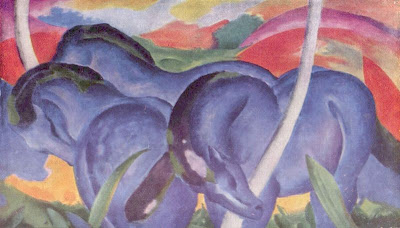I had not heard of him before and knew nothing about him, so I decided to find out what he did. My sources were all internet pages, including Wikipaedia, and www.august.macke.org which has his complete works online.
 |
| Self-Portrait of August Macke |
He was born in Germany, son of a builder, and brought up largely in the cities of Cologne, and then Bonn. Influences were his father's amateur paintings, Japanese prints, and a romantic painter of dramatic characters, Arnold Bocklin.
He studied at the Dusseldorf Art School, travelled in Europe, and did some stage design and costume work in the theatre in Dusseldorf.
He visited Paris in 1907 so saw some impressionists, and then joined Lovis Corinth studio in Berlin for a few months. Although Corinth later became more expressionist, at the time he was against the movement, and his work was naturalistic. Macke's art at this time was more post-impressionist, and he later did some more Fauve work.
Wikipaedia tells me that Fauve artists 'emphasised painterly qualities and strong colour over representational or realistic values retained by impressionists.'
 |
| Andre Durain - Self-portrait in the studio Fauvism |
 |
| Henri Matisse - Woman with a Hat Fauvism |
Der Blaue Reiter
This was a movement in Germany from 1911-1914 of some Russian imigrant painters including Kandinski, and some native Germans including Franz Marc, and August Macke. This movement was 'fundamental to' German Expressionism, and formed in response to rejection of one of Kandinski's paintings for an exhibition.
 |
| Wassily Kandinski - The Last Judgement From wikipaintings The painting that started Der Blaue Reiter movement |
Wikipaedia quotes Kandinski as saying that the name of the movement (meaning the Blue Rider) derived from Marc's love of horses, his love of riders, and both of their love of the blue. Kandinski saw blue as a spiritual colour.
 |
| Franz Marc - Die Grossen Blauen Pferde |
The group promoted primitive and children's art as well as the expression of the spiritual and music with the use of colour, by creating touring exhibitions, and almanacs. They were influenced by cubism and fauvism.
August Macke's Art:
As you might expect from an interested developing artist in rapidly changing artistic scene, there is a wide variety of styles in his work from the traditional naturalistic portraiture to much more abstract cubism-influenced styles.
He died fighting in the First World War in 1915, and it's tempting to wonder where his work might have gone as he got older if he had survived.
 |
| A Walk One of the more naturalistic of his paintings, with a lovely light to it reminiscent of the shimmering air of summer. |
 |
| Sunny Garden Which shoes the influence of the impressionists on his work |
 |
| Lady in a Green Jacket 1913 Which owes a lot in its colours and composition to Parisian post-impressionists |
The composition of this painting is what stands out for me - the main character in the foreground, but looking away in a thoughtful pose. The other people in triangular perspective with the trees, but with a very flat horizon, all in couples except for her.
 |
| Girl in the yellow jacket This one has both expressive colours and unnatural shapes -almost abstract. |
What appeals to me in this painting is the way he has used blocks of colour to describe the scene, which are not realistic but are strangely evocative of the experience. I have found when I have tried to use colour in blocks like this, that I am constrained whether I like it or not by what I 'know' to be the 'real' colour of the scene.
In my sketchbook I have drawn my foot in its constituent shapes in order to start exploring other ways of representing it on paper, and I can see that there's a lot of interesting directions I could go with it. Perhaps the next step would be to try out which colours work best to express my foot in this style!


No comments:
Post a Comment